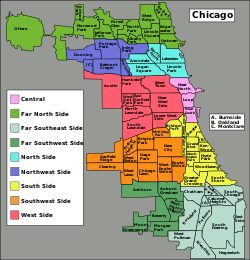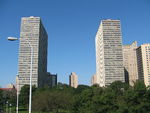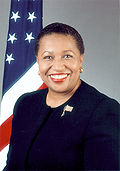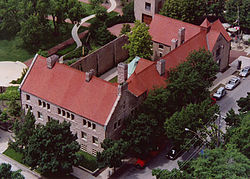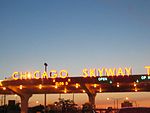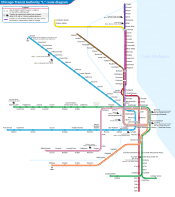South Side, Chicago
 From Wikipedia - Reading time: 36 min
From Wikipedia - Reading time: 36 min
South Side | |
|---|---|
District | |
 The Victory Monument, which is listed on the National Register of Historic Places, is located in the Black Metropolis-Bronzeville District near the starting point of the Bud Billiken Parade. | |
 | |
| Coordinates: 41°45′56″N 87°37′40″W / 41.76556°N 87.62778°W | |
| Country | United States |
| State | Illinois |
| County | Cook |
| City | Chicago |
| Elevation | 597 ft (182 m) |
| Time zone | UTC−06:00 (CST) |
| • Summer (DST) | UTC−05:00 (CDT) |
The South Side is one of the three major sections of the city of Chicago, Illinois, United States. Geographically, it is the largest of the three sections of the city, with the other two being the North and West Sides. It radiates and lies south of the city's downtown area, the Chicago Loop.
Much of the South Side came from the city's annexation of townships such as Hyde Park.[1] The city's Sides have historically been divided by the Chicago River and its branches.[2][3] The South Side of Chicago was originally defined as all of the city south of the main branch of the Chicago River,[4][5] but it now excludes the Loop.[3] The South Side has a varied ethnic composition and a great variety of income levels and other demographic measures.[6] It has a reputation for crime, although most crime is contained within certain neighborhoods, not throughout the South Side itself,[7][8] and residents range from affluent to middle class to poor.[9][10] South Side neighborhoods such as Armour Square, Back of the Yards, Bridgeport, and Pullman host more blue collar and middle-class residents, while Hyde Park, the Jackson Park Highlands District, Kenwood, Beverly, Mount Greenwood, and west Morgan Park range from middle class to more affluent residents.[11]
The South Side boasts a broad array of cultural and social offerings, such as professional sports teams, landmark buildings, museums, educational institutions, medical institutions, beaches, and major parts of Chicago's parks system. The South Side has numerous bus routes and 'L' train lines via the Chicago Transit Authority, it hosts Midway International Airport, and includes several Metra rail commuter lines.[12] There are portions of the U.S. Interstate Highway System and also national highways such as Lake Shore Drive.[13]
Boundaries
[edit]There is some debate as to the South Side's boundaries. Originally the sides were taken from the banks of the Chicago River. The city's address numbering system uses a grid demarcating Madison Street as the east–west axis and State Street as the north–south axis. Madison is in the middle of the Loop.[14] As a result, much of the downtown "Loop" district is south of Madison Street, and the river, but the Loop is usually excluded from any of the Sides.[3][6][15]
One definition has the South Side beginning at Roosevelt Road, at the Loop's southern boundary, with the community area known as the Near South Side immediately adjacent. Another definition, taking into account that much of the Near South Side is in effect part of the commercial district extending in an unbroken line from the South Loop, locates the boundary immediately south of 18th Street or Cermak Road, where Chinatown in the Armour Square community area begins.[4]
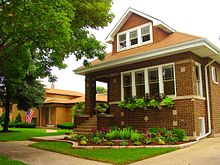
Lake Michigan and the Indiana state line provide eastern boundaries. The southern border changed over time because of Chicago's evolving city limits. The city limits are now at 138th Street, in Riverdale and Hegewisch.[16] The South Side is larger in area than the North and West Sides combined.
Neighborhoods
[edit]Out of 77 community areas in the city, the South Side of Chicago comprises a total of 42 neighborhoods, with some divided into different regions of the area or consolidated into Chicago as part of the annexation of various townships within Cook County.[17]
South Side
[edit]- Armour Square
- Bridgeport
- Douglas
- Englewood (half of Englewood on its far left is connected with the Southwest Side of Chicago)
- Fuller Park
- Grand Boulevard
- Greater Grand Crossing
- Hyde Park
- Kenwood
- Oakland
- South Shore
- Washington Park
- Woodlawn
Southwest Side
[edit]- Archer Heights
- Brighton Park
- Chicago Lawn
- Clearing
- Gage Park
- Garfield Ridge
- McKinley Park
- New City
- West Elsdon
- West Englewood
- West Lawn
Far Southwest Side
[edit]Far Southeast Side
[edit]- Avalon Park
- Burnside
- Calumet Heights
- Chatham
- East Side
- Hegewisch
- Pullman
- Riverdale
- Roseland
- South Chicago
- South Deering
- West Pullman
Subdivisions
[edit]The exact boundaries dividing the Southwest, South, and Southeast Sides vary by source.[15] If primarily racial lines are followed, the South Side can generally be divided into a White and Hispanic Southwest Side, a largely Black South Side and a smaller, more racially diverse Southeast Side centered on the East Side community area and including the adjacent community areas of South Chicago, South Deering and Hegewisch.[19]
The differing interpretations of the boundary between the South and Southwest Sides are due to a lack of a definite natural or artificial boundary.[15] One source states that the boundary is Western Avenue or the railroad tracks adjacent to Western Avenue.[6] This border extends further south to a former railroad right of way paralleling Beverly Avenue and then Interstate 57.
The Southwest Side of Chicago is a subsection of the South Side comprising mainly white, black, and Hispanic neighborhoods, usually dominated by one of these races. On the Southwest Side exclusively, the northern portion has a high concentration of Hispanics, the western portion has a high concentration of whites, and the eastern portion has a high concentration of blacks. Architecturally, the Southwest Side is distinguished by the tract of Chicago's Bungalow Belt, which runs through it.[20]
Archer Heights, a Polish enclave along Archer Avenue, which leads toward Midway Airport, is located on the Southwest Side of the city, as are Beverly and Morgan Park, home to a large concentration of Irish Americans.
History
[edit]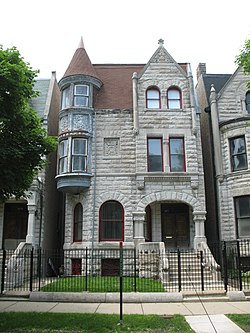
With its factories, steel mills and meat-packing plants, the South Side saw a sustained period of immigration which began around the 1840s and continued through World War II. Irish, Italian, Polish, Lithuanian and Yugoslav immigrants, in particular, settled in neighborhoods adjacent to industrial zones.[21]
The Illinois Constitution gave rise to townships that provided municipal services in 1850. Several settlements surrounding Chicago incorporated as townships to better serve their residents. Growth and prosperity overburdened many local government systems. In 1889, most of these townships determined that they would be better off as part of a larger city of Chicago. Lake View, Jefferson, Lake, Hyde Park Townships and the Austin portion of Cicero voted to be annexed by the city in the June 29, 1889, elections.[1][22][23]
After the Civil War freed millions of slaves, during Reconstruction black southerners migrated to Chicago and caused the black population to nearly quadruple from 4,000 to 15,000 between 1870 and 1890.[24]
In the 20th century, the numbers expanded with the Great Migration, as blacks left the agrarian South seeking a better future in the industrial North, including the South Side. By 1910, the black population in Chicago reached 40,000, with 78% residing in the Black Belt.[24][25] Extending 30 blocks, mostly between 31st and 55th Streets,[26] along State Street, but only a few blocks wide,[24] it developed into a vibrant community dominated by black businesses, music, food and culture.[25] As more blacks moved into the South Side, descendants of earlier immigrants, such as ethnic Irish, began to move out. Later housing pressures and civic unrest caused more whites to leave the area and the city. Older residents of means moved to newer suburban housing as new migrants entered the city,[27][28] driving further demographic changes.

The South Side was racially segregated for many decades. During the 1920s and 1930s, housing cases on the South Side such as Hansberry v. Lee, 311 U.S. 32 (1940), went to the U. S. Supreme Court.[29] The case, which reset the limitations of res judicata, successfully challenged racial restrictions in the Washington Park Subdivision by reopening them for legal argument.[29] Blacks resided in Bronzeville (around 35th and State Streets) in an area called "the Black Belt". After World War II, blacks spread across the South Side; its center, east, and western portions. The Black Belt arose from discriminatory real estate practices by whites against blacks and other racial groups.[21]
In the early 1960s,[30] during the tenure of then Mayor Richard J. Daley, the construction of the Dan Ryan Expressway created controversy. Many perceived the highway's location as an intentional physical barrier between white and black neighborhoods,[31] particularly as the Dan Ryan divided Daley's own neighborhood, the traditionally Irish Bridgeport, from Bronzeville.[32]
The economic conditions that led to migration into the South Side were not sustained. Mid-century industrial restructuring in meat packing and the steel industry cost many jobs. Blacks who became educated and achieved middle-class jobs also left after the Civil Rights Movement to other parts of the city.
Street gangs have been prominent in some South Side neighborhoods for over a century, beginning with those of Irish immigrants, who established the first territories in a struggle against other European and black migrants. Some other neighborhoods stayed relatively safe for a big city. By the 1960s, gangs such as the Vice Lords began to improve their public image, shifting from criminal ventures to operating social programs funded by government and private grants. However, in the 1970s gangs returned to violence and the drug trade. By 2000, traditionally all-male gangs crossed gender lines to include about 20% females.[33]
Housing
[edit]By the 1930s, the city of Chicago boasted that over 25% of its residential structures were less than 10 years old, many of which were bungalows. These continued to be built in the working-class South Side into the 1960s.[34][35] Studio apartments, with Murphy beds and kitchenettes or Pullman kitchens, comprised a large part of the housing supply during and after the Great Depression, especially in the "Black Belt".[36] The South Side had a history of philanthropic subsidized housing dating back to 1919.[37]
The United States Congress passed the Housing Act of 1949 to fund and improve public housing. CHA produced a plan of citywide projects, which was rejected by the Chicago City Council's white aldermen who opposed public housing in their wards. This led to a CHA policy of construction of family housing only in black residential areas, concentrated on the South and West Sides.[38] Historian Arnold R. Hirsch said the CHA was "a bulwark of segregation that helped sustain Chicago's 'second ghetto'".[39]
Gentrification
[edit]Gentrification of parts of the Douglas community area has bolstered the Black Metropolis-Bronzeville District.[40] Gentrification in various parts of the South Side has displaced many black citizens.[41] The South Side offers numerous housing cooperatives. Hyde Park has several middle-income co-ops and other South Side regions have limited equity (subsidized, price-controlled) co-ops.[42] These regions experienced condominium construction and conversion in the 1970s and 1980s.[42]

In the late 20th century, the South Side had some of the poorest housing conditions in the U.S., but the Chicago Housing Authority (CHA) began replacing the old high-rise public housing with mixed-income, lower-density developments, part of the city's Plan for Transformation.[43] Many of the CHA's massive public housing projects, which lined several miles of South State Street, have been demolished. Among the largest were the Robert Taylor Homes.[44]
Demographics
[edit]Some census tracts (4904 in Roseland, 7106 in Auburn Gresham) are 99% black.[45]
Hyde Park is home to the University of Chicago, as well as the South Side's largest Jewish population, centered on Chicago's oldest synagogue, the Chicago Landmark KAM Isaiah Israel.[46] The Southwest Side's ethnic makeup also includes the largest concentration of Gorals (Carpathian highlanders) outside of Europe; it is the location of the Polish Highlanders Alliance of North America.[47] A large Mexican-American population resides in Little Village (South Lawndale) and areas south of 99th Street.[48]
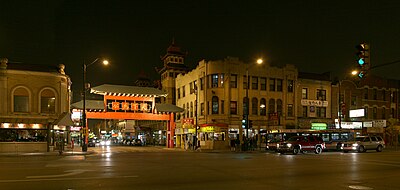
Ethnic parades
[edit]The South Side Irish Parade occurs in the Beverly neighborhood along Western Avenue each year on the Sunday before St. Patrick's Day. The parade, which was founded in 1979, was at one time said to be the largest Irish neighborhood St. Patrick's celebration in the world outside of Dublin, Ireland,[49] and was—until being scaled back in 2012—actually larger than Chicago's other St. Patrick's Day parade in the Loop. The South Side parade became such an event that it was broadcast on Chicago's CBS affiliate.[50][51]
Following the 2009 parade, organizers stated the group was "not planning to stage a parade in its present form".[51] The parade was cancelled in 2010 and 2011 before being revived with more strict security and law enforcement.[52] The Bud Billiken Parade and Picnic, the second largest parade in the U.S. and the nation's largest black parade,[53] runs annually on Martin Luther King Drive between 31st and 51st Streets in the Bronzeville neighborhood, through the main portion of the South Side.
Economic development
[edit]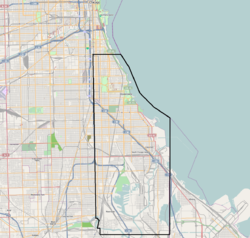
Neighborhood rehabilitation, and in some cases, gentrification, can be seen in parts of Washington Park, Woodlawn (#42) and Bronzeville, as well as in Bridgeport and McKinley Park. Historic Pullman's redevelopment is another example of a work in progress. Chinatown is located on the South Side and has seen a surge in growth. It has become an increasingly popular destination for both tourists and locals alike and is a cornerstone of the city's Chinese community.[citation needed] The South Side offers many outdoor amenities, such as miles of public lakefront parks and beaches, as it borders Lake Michigan on its eastern side.[citation needed]
Today's South Side is mostly a combination of the former Hyde Park and Lake Townships. Within these townships many had made speculative bets on future prosperity. Much of the South Side evolved from these speculative investments. Stephen A. Douglas, Paul Cornell, George Pullman and various business entities developed South Chicago real estate. The Pullman District, a former company town, Hyde Park Township, various platted communities and subdivisions were the results of such efforts.[54]
The Union Stock Yards, which were once located in the New City community area (#61), at one point employed 25,000 people and produced 82 percent of US domestic meat production.[55] They were so synonymous with the city that for over a century they were part of the lyrics of Frank Sinatra's "My Kind of Town", in the phrase: "The Union Stock Yard, Chicago is ..." The Union Stock Yard Gate marking the old entrance to stockyards was designated a Chicago Landmark on February 24, 1972,[56] and a National Historic Landmark on May 29, 1981.[57][58]
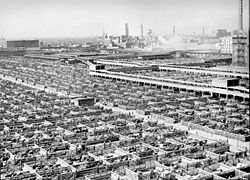
Other South Side regions have been known for great wealth, such as Prairie Avenue. 21st century redevelopment includes One Museum Park and One Museum Park West.[59]
The South Side accommodates much of the city's conference business with various convention centers. The current McCormick Place Convention Center is the largest convention center in the U.S. and the third largest in the world.[60] Previously, the South Side hosted conventions at the Chicago Coliseum and the International Amphitheatre.[6] The Ford City Mall and the surrounding shopping district includes several big-box retailers.
Political figures
[edit]The South Side has been home to some of the most significant figures in the history of American politics. These include Richard J. Daley and his son, Richard M. Daley; the first black president of the United States, Barack Obama and former first lady Michelle Obama; the first black female U.S. Senator, Carol Moseley Braun; and the first black presidential candidate to win a primary, Jesse Jackson. Before them, Harold Washington, a Congressman and the first black Mayor of Chicago, as well as groundbreaking Congressman William L. Dawson, achieved political success from the South Side.[61]
-
Carol Moseley Braun, the first Black female U.S. Senator
-
Jesse Jackson, the first Black presidential candidate to win a primary
Education
[edit]Colleges and universities
[edit]The University of Chicago is one of the world's leading universities, counting 97 affiliated Nobel laureates.[62] At Chicago Pile-1 at the university, the first self-sustaining nuclear chain reaction was achieved under the direction of Enrico Fermi in the 1940s.[63]
Other four-year educational institutions there are the Illinois Institute of Technology, St. Xavier University, Chicago State University, Illinois College of Optometry and Shimer College.[64] The South Side also hosts community colleges such as Olive-Harvey College, Kennedy-King College and Richard J. Daley College.[65]
Primary and secondary schools
[edit]Chicago Public Schools operates the public schools on the South Side, including DuSable High School, Simeon Career Academy, John Hope College Prep High School and Phillips Academy High School.[66][67][68][69] The De La Salle Institute, located in the Douglas community area across the street from Chicago Police Department headquarters, has taught five Chicago Mayors:[70] Richard J. Daley, Michael A. Bilandic, Martin H. Kennelly, Frank J. Corr and Richard M. Daley. Three of these mayors hail from the South Side's Bridgeport community area, which also produced two other Chicago Mayors.[71]
University of Chicago Lab School, affiliated with the University of Chicago, is a private school located there.[64]
Landmarks
[edit]The South Side is home to many official landmarks and other notable buildings and structures.[72][73] It hosts three of the four Chicago Registered Historic Places from the original October 15, 1966 National Register of Historic Places list (Chicago Pile-1, Robie House and Lorado Taft Midway Studios).[74]
One Museum Park, which is along Roosevelt Road, is the tallest building on the South Side.[75] One Museum Park West, which is next door to One Museum Park, is another of Chicago's tallest. 1700 East 56th Street in Hyde Park is the tallest building south of 13th Street. This neighborhood hosts several other highrises.
Many landmark buildings are found in the Black Metropolis-Bronzeville District,[76] including Powhatan Apartments, Robie House and John J. Glessner House.[77][78][79] The South Side has many of Chicago's premier places of worship such as Eighth Church of Christ, Scientist, First Church of Deliverance and K.A.M. Isaiah Israel Temple.[46][80][81]
The South Side has several landmark districts including two in Barack Obama's Kenwood community area: Kenwood District, North Kenwood District and (partially) Hyde Park-Kenwood Historic District.[82][83] The South Side hosts the Museum of Science and Industry,[84] located in the Palace of Fine Arts, one of the few remaining buildings from the 1893 World's Columbian Exposition,[85] which was hosted in South Side.

The South Side is the residence of other prominent black leaders such as Jesse Jackson and Louis Farrakhan. It is also where U.S. Congressman Bobby Rush, a former Black Panther leader, serves.[63]
The South Side has been a place of political controversy. Although the locations of some of these notable controversies have not become official landmarks, they remain important parts of Chicago history. The Chicago Race Riot of 1919 was the worst of the approximately 25 riots during the Red Summer of 1919 and required 6,000 National Guard troops.[86] As mentioned above, segregation has been a political theme of controversy for some time on the South Side as exhibited by Hansberry v. Lee, 311 U.S. 32 (1940).[87]
President Obama announced in 2015 that the Barack Obama Presidential Center would be built adjacent the University of Chicago campus.[88][89] Both Washington Park and Jackson Park were considered and it was announced in July 2016 that it would be built in Jackson Park.[90]
Transportation
[edit]The South Side is served by mass transit as well as roads and highways. Midway International Airport is located on the South Side.[91][92] Among the highways through the South Side are I-94 (which goes by the names Dan Ryan Expressway, Bishop Ford Freeway and Kingery Expressway on the South Side), I-90 (which goes by the names Dan Ryan Expressway and Chicago Skyway on the South Side), I-57, I-55, U.S. 12, U.S. 20 and U.S. 41.[93]
Several Chicago Transit Authority (CTA) bus and train lines and Metra train lines link the South Side to rest of the city. The South Side is served by the Red, Green and Orange lines of the CTA and the Rock Island District, Metra Electric and South Shore Metra lines and a few stops on the SouthWest Service Metra line. Standard local metropolitan bus service and CTA express service bus routes provide service to the Loop.[94]
Arts
[edit]Chicago's African American community, concentrated on the South Side, experienced an artistic movement from the 1930s until the 1960s. The movement was concentrated in and around the Hyde Park community area. Prominent writers and artists included Gwendolyn Brooks, Margaret Burroughs, Elizabeth Catlett, Eldzier Cortor, Richard Hunt, Gordon Parks, and Richard Wright.[95]
Other Chicago Black Renaissance artists included Willard Motley, William Attaway, Frank Marshall Davis, and Margaret Walker. St. Clair Drake and Horace R. Cayton represented the new wave of intellectual expression in literature by depicting the culture of the urban ghetto rather than the culture of blacks in the South in the monograph Black Metropolis.[24][96] In 1961, Burroughs founded the DuSable Museum of African American History. By the late 1960s the South Side had a robost art movement led by Jim Nutt, Gladys Nilsson, Karl Wirsum and others, who became known as the Chicago Imagists.
Music in Chicago flourished, with musicians bringing blues and gospel influences up from the South and creating a Chicago sound in blues and jazz that the city is still renowned for. The South Side was known for its R&B acts and the city as a while had successful rock acts. Many major and independent record companies had a presence in Chicago.[97] In 1948, Blues was introduced by Aristocrat Records (later Chess Records). Muddy Waters and Chess Records quickly followed with Chuck Berry, Bo Diddley, Little Walter, Jimmy Rogers, and Howlin' Wolf.[24][98]
Vee-Jay, the largest black-owned label before Motown Records, was among the post-World War II companies that formed "Record Row" on Cottage Grove between 47th and 50th Streets. In the 1960s, it was located along South Michigan Avenue.[97][98] Rhythm and blues continued to thrive after Record Row became the hub of gospelized rhythm and blues, known as soul. Chicago continues as a prominent musical city.[98]
Many other artists have left their mark on Chicago's South Side. These include writers Upton Sinclair and James Farrell, Archibald Motley Jr. via painting, Henry Moore and Lorado Taft via sculpture and Thomas Dorsey and Mahalia Jackson via gospel music.[6] The South Side has many art museums and galleries such as the DuSable Museum of African American History,[99] National Museum of Mexican Art,[100] National Vietnam Veterans Art Museum,[101] and the David and Alfred Smart Museum of Art (known as the Smart Museum).[102] In addition, cultural centers such as the South Shore Cultural Center, South Side Community Art Center, Harold Washington Cultural Center and Hyde Park Art Center bring art and culture to the public while fostering opportunities for artists.[103] The Bronzeville Children's Museum is the only African American Children's museum in the U.S.[104]
Parks
[edit]The Chicago Park District boasts 7,300 acres (30 km2) of parkland, 552 parks, 33 beaches, nine museums, two world-class conservatories, 16 historic lagoons and ten bird/wildlife gardens.[105] Many of these are on the South Side, including several large parks that are part of the legacy of Paul Cornell's service on the South Parks Commission. He was also the father of Hyde Park.
Chicago Park District parks serving the South Side include Burnham Park,[106] Jackson Park,[107] Washington Park,[108] Midway Plaisance,[109] and Harold Washington Park.[110] Away from the Hyde Park area, large parks include the 69-acre (28 ha) McKinley Park,[111] 323-acre (131 ha) Marquette Park,[112] the 198-acre (80 ha) Calumet Park,[113] and the 173-acre (70 ha) Douglass Park.[114] The parks of Chicago foster and host tremendous amounts of athletic activities.
The South Side has the only Illinois state park within the city of Chicago: William W. Powers State Recreation Area. Other opportunities for more "natural" recreation are provided by the Cook County Forest Preserve's Dan Ryan Woods and the Beaubien Woods on the far south side, along the Little Calumet River[115]
Various events cause the closure of parts of Lake Shore Drive. Although the Chicago Marathon causes many roads to be closed in its route that goes as far north as Wrigleyville and to Bronzeville on the South Side, it does not cause closures to the drive.[116] On the South Side, the Chicago Half Marathon necessitates closures[117] and the entire drive is closed for Bike The Drive.[118]
Beginning in 1905, the White City Amusement Park, located on 63rd Street provided a recreational area to the citizens of the area.[119][120] Until the early 1920s, a dirigible service ran from the park, which was also where Goodyear Blimps were first produced, to Grant Park. This service was discontinued after the Wingfoot Air Express Crash.[121] A fire destroyed much of the park in the late 1920s and more was torn down in the 1930s. The park filed for bankruptcy in 1933 and 1943. Despite attempts to resurrect the park in 1936 and 1939, by 1946 all the remaining equipment was auctioned off.[122]
Sports
[edit]The South Side hosts three major professional athletic teams: Major League Baseball's Chicago White Sox play at Rate Field in the Armour Square neighborhood, while the National Football League's Chicago Bears and Chicago Fire FC of Major League Soccer play at Soldier Field, adjacent to the Museum Campus on the Near South Side.[123][124][125]
Nine other teams—five now defunct, two playing in other media markets, and two now playing in another part of Chicago—have called the South Side home. When the National League baseball team now known as the Chicago Cubs was founded in 1870, their first playing field was Dexter Park in the Back of the Yards neighborhood. From 1874 to 1877 they played at 23rd Street Grounds in what is now Chinatown, and from 1891 to 1893 they played some of their games at South Side Park, which was located in the same place that Comiskey Park was built for the Chicago White Sox in 1910. South Side Park was also home to the Chicago Pirates of the short-lived Player's League in 1890. Another baseball field, also known as South Side Park, stood nearby in 1884 and was home to the Chicago Unions of the equally short-lived Union League.[126]
The defunct Chicago American Giants baseball club of the Negro leagues played at Schorling's Park from 1911 to 1940,[6] and then at Comiskey Park until 1952. In football, the Chicago Cardinals of the National Football League originally played at Normal Park but eventually moved to Comiskey Park in the late 1920s.[6] The Cardinals left Chicago for St. Louis in 1960 and in 1988 for Phoenix, where they became the Arizona Cardinals.[127] In hockey, the Chicago Cougars of the WHA played in the International Amphitheatre, located next to the Union Stock Yards, from 1972 until their demise in 1975.[128]
Two NBA teams also briefly played on the South Side. The Chicago Packers played at the Amphitheatre in their inaugural season of 1961–62. The following season, they changed their name to the Zephyrs and played at the Chicago Coliseum on the Near South Side. The team moved to Baltimore after that season and now plays in Washington, D.C., as the Washington Wizards.[129] Chicago's current NBA team, the Bulls, played at the Amphitheatre during their first season[130] before moving away from the South Side to Chicago Stadium and eventually to United Center.
The Chicago Sky of the WNBA moved to Wintrust Arena, which opened in 2017 at McCormick Place on the Near South Side, in 2018. The venue is also home to both the men's and women's basketball teams of DePaul University, with the men exclusively using Wintrust Arena and the women splitting home games between that venue and DePaul's North Side campus.[131]
The defunct Chicago Sting soccer club played at Soldier Field and Comiskey Park from 1974 to 1984.[132][133]
In NCAA Division I sports, the Chicago State Cougars represent the South Side, competing in the Western Athletic Conference. As noted above, DePaul began playing its home men's basketball games on the South Side in 2017, though most of its other sports (including part of the women's basketball home schedule) remain on or near its main North Side campus.
2016 Olympic bid
[edit]The South Side played a prominent role in Chicago's bid for the 2016 Summer Olympics. The Olympic Village was planned in the Douglas (#35) community area across Lake Shore Drive from Burnham Park.[134] In addition, the Olympic Stadium was expected to be located in the Chicago Park District's Washington Park located in the Washington Park (#40) community area.[135] Many Olympic events were planned for these community areas as well as other parts of the South Side.[136]
References in popular culture
[edit]The South Side's gritty reputation often makes its way into popular culture.
- The opening lines of Jim Croce's 1973 song "Bad, Bad Leroy Brown" state that the South Side is "the baddest part of town".[137]
- Richard Wright's novel Native Son (ISBN 978-0-06-083756-3) takes place on the South Side and focuses on the plight of African Americans in the ghetto, including the housing practices that created such slums.[138]
- Upton Sinclair's novel The Jungle (ISBN 978-1-884365-30-0) was a revelation about the Union Stock Yards at the turn of the 20th century.[139]
- A Raisin in the Sun (ISBN 978-0-451-18388-0) is a story of Lorraine Hansberry's youth growing up in the Woodlawn community area.[140]
- Barbershop and parts of The Blues Brothers take place on the South Side. David Auburn's play Proof takes place exclusively in the Hyde Park neighborhood; the 2005 film adaptation expands the setting.[141]
- The Spook Who Sat by the Door is a novel and film dealing with the integration of the CIA. The majority of the story takes place on the South Side of Chicago where the sole graduating black cadet is from.[142]
- The Boondocks, a comic strip and animated series, stars the Freeman family, who have recently moved from the South Side of Chicago to an affluent suburb.[143]
- James T. Farrell's novels, collectively called the Studs Lonigan Trilogy, are set in an Irish neighborhood on the South Side.[144]
- Iceberg Slim, the author of Pimp, was raised on the South Side of Chicago, which is the setting of most of his stories. He sold over six million books, which were translated, further disseminating his depiction of life of the South Side.[145]
- Chicago's South Side is the setting for the Showtime series Shameless and the Chicago Fire, Chicago Med and Chicago PD TV series produced by Dick Wolf.
- The South Side is seen in Netflix's Sense8 series, in the scenes of Will.
- Kanye West was raised in Chicago's South Side and frequently mentions it in his music. His lyrical references are heard in the song "All Falls Down" where he can be heard saying "South Side, South Side, we gon' set this party off right". Other examples include "All Day" ("South, South, South Side"), "Feedback" (You borrow our motto, I'm a Chicago south sider) Famous ("For all my Southside n***as that know me best), and Wash Us in the Blood ("South Side let it bang, outside let it rain", and later in the song - "South Side what it does").
- In the 2004 film Mean Girls, which takes place in Evanston, Illinois, Mr. Duvall responds to a school-wide fight with, "Oh hell no, I did not leave the South Side for this!"
- The TV series South Side was co-created and written by Bashir Salahuddin, who was born and raised on the South Side.
- Chief Keef was raised on the South Side of Chicago, in the Parkway Garden Homes. He references the South Side in his music, such as the song "South Side". He references the South Side in the song "Almighty Gnar", with Lil Gnar.
See also
[edit]Citations
[edit]- ^ a b Cain, Louis P. (2005). "Annexation". The Electronic Encyclopedia of Chicago. Chicago Historical Society. Archived from the original on September 19, 2008. Retrieved September 8, 2008.
- ^ "City Layout". Frommers.com. 2007. Archived from the original on October 12, 2000. Retrieved October 28, 2007.
- ^ a b c Nobleman, Marc Tyler (2005). Chicago. Gareth Stevens, Inc. p. 7. ISBN 978-0-8368-5196-0. Archived from the original on March 13, 2024. Retrieved October 28, 2007.
- ^ a b "Chicago (city, Illinois)". Microsoft Encarta Online Encyclopedia. Microsoft Corporation. 2007. Archived from the original on August 13, 2007. Retrieved August 13, 2007.
- ^ "The Municipal Flag of Chicago". Chicago Public Library. Archived from the original on March 30, 2013. Retrieved October 28, 2007.
- ^ a b c d e f g Pacyga, Dominic A. (2005). "South Side". The Electronic Encyclopedia of Chicago. Chicago Historical Society. Archived from the original on October 17, 2007. Retrieved August 10, 2007.
- ^ Sobel, Anne (February 14, 2011). "What the South Side of Chicago Could Learn from Egypt". The Huffington Post. Archived from the original on September 15, 2016. Retrieved October 4, 2012.
- ^ Tough, Paul (August 15, 2012). "What Does Obama Really Believe In?". The New York Times Magazine. Archived from the original on September 28, 2012. Retrieved October 4, 2012.
- ^ "Housing, A Short History". You Are Here. The University of Chicago. 2007. Archived from the original on November 27, 2020. Retrieved August 19, 2007.
- ^ "Cinéma vérité". The University of Chicago Magazine. 2007. Archived from the original on August 7, 2020. Retrieved August 19, 2007.
- ^ "Chicago Demographics: Median Household Income (as of the 2000 Census)" (PDF). CityofChicago.org. Retrieved October 31, 2007.[permanent dead link]
- ^ "The RTA system" (PDF). The Regional Transportation Authority. February 21, 2007. Archived from the original (PDF) on November 27, 2007. Retrieved October 25, 2007.
- ^ "FHWA Route Log and Finder List: Table 1". Federal Highway Administration. March 22, 2007. Archived from the original on April 22, 2012. Retrieved October 25, 2007.
- ^ Hayner, Don and Tom McNamee, Streetwise Chicago, "Madison Street", p. 79, Loyola University Press, 1988, ISBN 978-0-8294-0597-2
- ^ a b c Eric Zorn (May 30, 2005). "Sides Up in the Air". Chicago Tribune. Archived from the original on May 29, 2008. Retrieved October 25, 2007.
- ^ "Hegewisch". Field Museum of Natural History. Archived from the original on January 21, 2016. Retrieved November 25, 2012.
- ^ Hyde Park Township, A Chicago Annexed Neighborhood (PDF). Living History of Illinois and Chicago®. p. 3. Archived (PDF) from the original on February 9, 2023. Retrieved February 9, 2023.
- ^ "Chicago Demographics: Distribution of Black Residents Across City (as of the 2000 Census)" (PDF). CityofChicago.org. 2007. Retrieved October 31, 2007.[permanent dead link]
- ^ "Chicago's Southeast Side". Northeastern Illinois University. 2007. Archived from the original on July 9, 2007. Retrieved August 13, 2007.
- ^ Durkin Keatingj, Ann. "Bungalow Belt". Encyclopedia of Chicago. Chicago Historical Society. Archived from the original on October 10, 2012. Retrieved November 13, 2012.
- ^ a b Bennett, Larry (2005). "Ghettoization". The Electronic Encyclopedia of Chicago. Chicago Historical Society. Archived from the original on September 29, 2007. Retrieved August 13, 2007.
- ^ Keating, Ann Durkin (2005). "Townships". The Electronic Encyclopedia of Chicago. Chicago Historical Society. Archived from the original on November 2, 2007. Retrieved October 23, 2007.
- ^ Keating, Ann Durkin (2005). "Annexations and Additions to the City of Chicago". The Electronic Encyclopedia of Chicago. Chicago Historical Society. Archived from the original on April 23, 2007. Retrieved October 23, 2007.
- ^ a b c d e Manning, Christopher (2005). "blacks". The Electronic Encyclopedia of Chicago. Chicago Historical Society. Archived from the original on January 23, 2009. Retrieved August 10, 2007.
- ^ a b Ralph 2006, p. 175
- ^ Ralph 2006, p. 174
- ^ Gurlacz, Betsy (2005). "Oak Lawn, IL". The Electronic Encyclopedia of Chicago. Chicago Historical Society. Archived from the original on August 20, 2007. Retrieved August 10, 2007.
- ^ Barnes, R. (2009). "Arnold R. Hirsch, Making the Second Ghetto: Race and Housing in Chicago, 1940–1960 (London: Cambridge Univ. Press, 1983, £20). Pp. Xv, 362. ISBN 0 521 24569 9". Journal of American Studies. 19: 130. doi:10.1017/S0021875800020211. S2CID 146381277.
- ^ a b Kamp, Allen R. (1986). "The History Behind Hansberry v. Lee" (PDF). U.C. Davis Law Review. 20: 481. Archived (PDF) from the original on May 21, 2013. Retrieved November 15, 2012.
- ^ McClendon, Dennis (2005). "Expressways". The Electronic Encyclopedia of Chicago. Chicago Historical Society. Archived from the original on January 2, 2012. Retrieved January 29, 2013.
- ^ "Chicago history and rebuilding the Dan Ryan". Chicago Defender. Real Times. February 4, 2004. Archived from the original on May 18, 2013.
- ^ Royalty, Doug (May 29, 2000). "The Czar of Chicago". businessweek.com. Bloomberg Business Week. Archived from the original on October 19, 2012. Retrieved May 3, 2012.
- ^ Diamond, Andrew J. (2005). "Gangs". The Electronic Encyclopedia of Chicago. Chicago Historical Society. Archived from the original on August 10, 2007. Retrieved August 10, 2007.
- ^ Bigott, Joseph C. (2005). "Bungalows". The Electronic Encyclopedia of Chicago. Chicago Historical Society. Archived from the original on August 27, 2007. Retrieved August 13, 2007.
- ^ Keating, Ann Durkin (2005). "Bungalow Belt". The Electronic Encyclopedia of Chicago. Chicago Historical Society. Archived from the original on August 16, 2007. Retrieved August 13, 2007.
- ^ Plotkin, Wendy (2005). "Kitchenettes". The Electronic Encyclopedia of Chicago. Chicago Historical Society. Archived from the original on August 24, 2007. Retrieved August 13, 2007.
- ^ Bowly Jr., Devereux (2005). "Subsidized Housing". The Electronic Encyclopedia of Chicago. Chicago Historical Society. Archived from the original on November 8, 2009. Retrieved August 13, 2007.
- ^ Choldin, Harvey M. (2005). "Chicago Housing Authority". The Electronic Encyclopedia of Chicago. Chicago Historical Society. Archived from the original on August 20, 2007. Retrieved August 13, 2007.
- ^ Hirsch, Arnold R. (1995). "Massive Resistance in the Urban North: Trumbull Park, Chicago, 1953-1966". The Journal of American History. 88 (2): 524. doi:10.2307/2082185. JSTOR 2082185.
- ^ Bennett, Larry (2005). "Gentrification". The Electronic Encyclopedia of Chicago. Chicago Historical Society. Archived from the original on September 7, 2007. Retrieved August 10, 2007.
- ^ Seligman, Amanda (2005). "North Lawndale". The Electronic Encyclopedia of Chicago. Chicago Historical Society. Archived from the original on January 30, 2013. Retrieved August 10, 2007.
- ^ a b Steffes, Tracy (2005). "Condominiums and Cooperatives". The Electronic Encyclopedia of Chicago. Chicago Historical Society. Archived from the original on August 20, 2007. Retrieved August 13, 2007.
- ^ "The CHA's Plan for Transformation". Chicago Housing Authority. 2007. Archived from the original on August 9, 2007.
- ^ Gellman, Erik (2005). "Robert Taylor Homes". The Electronic Encyclopedia of Chicago. Chicago Historical Society. Archived from the original on May 16, 2008. Retrieved April 25, 2008.
- ^ "U.S. Census website". United States Census Bureau. Archived from the original on July 9, 2021. Retrieved November 25, 2012.
- ^ a b "K.A.M. Isaiah Israel Temple". City of Chicago Department of Planning and Development, Landmarks Division. 2003. Archived from the original on April 14, 2008. Retrieved May 4, 2012.
- ^ "Kontakt ZP". zppa.org. Archived from the original on June 30, 2012. Retrieved November 10, 2012.
- ^ Gellman, Erik (2005). "Little Village". Encyclopedia of Chicago. Chicago Historical Society. Archived from the original on October 13, 2012. Retrieved November 13, 2012.
- ^ "South Side Irish Parade Expected To Draw Record Crowd". Market Wire. FindArticles. March 2002. Archived from the original on July 12, 2012. Retrieved September 27, 2007.
- ^ Puccinelli, Mike. "Pray, Parade and Party At South Side Irish Parade". CBS Broadcasting, Inc. Archived from the original on March 17, 2007. Retrieved September 27, 2007.
- ^ a b The South Side Irish St. Patrick's Day Parade Committee (March 25, 2009). "Céad Míle Fáílte". South Side Irish Saint Patrick's Day Parade. Archived from the original on March 29, 2009. Retrieved March 25, 2009.
- ^ "South Side Irish Parade: Fines Up To $1,000 Could Help Keep 'Idiots' Away". The Huffington Post. November 1, 2012. Archived from the original on November 3, 2012. Retrieved November 17, 2012.
- ^ "ABC 7 Chicago Presents Live Broadcast Of The Bud Billiken Parade". ABC Inc., WLS-TV Chicago. 2006. Archived from the original on March 21, 2007. Retrieved September 28, 2007.
- ^ deVise, Pierre (2005). "Real Estate". The Electronic Encyclopedia of Chicago. Chicago Historical Society. Archived from the original on August 12, 2007. Retrieved August 13, 2007.
- ^ "Meatpacking Technology". Chicago Historical Society. 2001. Archived from the original on April 4, 2007. Retrieved March 9, 2007.
- ^ "Chicago Landmarks: Union Stock Yard Gate". City of Chicago Department of Planning and Development, Landmarks Division. 2003. Archived from the original on February 3, 2007. Retrieved May 4, 2012.
- ^ "National Historic Landmarks Survey: Listing of National Historic Landmarks by State: Illinois" (PDF). Archived from the original (PDF) on February 28, 2011. Retrieved March 7, 2007.
- ^ "Old Stone Gate, Chicago Union Stockyards". National Park Service. Archived from the original on May 28, 2008. Retrieved March 30, 2007.
- ^ Reiff, Janice L. (2005). "The Worlds of Prairie Avenue". The Electronic Encyclopedia of Chicago. Chicago Historical Society. Archived from the original on December 3, 2007. Retrieved October 18, 2007.
- ^ "Ramada Lake Shore Chicago". ramada-Chicago.com. Archived from the original on October 15, 2007. Retrieved October 22, 2007.
- ^ Williams, Joseph (November 2, 2008). "Obama's home has long produced black stars". Boston Globe. Archived from the original on April 28, 2009. Retrieved March 18, 2009.
- ^ "Nobel Prizes". www.uchicago.edu. Archived from the original on October 22, 2022. Retrieved October 14, 2022.
- ^ a b Apple, R. W. Jr. (March 31, 2000). "ON THE ROAD; Big Shoulders, Buffed for Action". The New York Times. Archived from the original on May 30, 2008. Retrieved April 20, 2008.
- ^ a b "America's Best Colleges 2008: National Universities: Top Schools". U.S. News & World Report, L.P. Archived from the original on July 30, 2008. Retrieved October 17, 2007.
- ^ "Chicago Demographics:Distribution of Residents Whose Highest Education is a Master's Degree or Ph.D. (as of the 2000 Census)" (PDF). City of Chicago.org. 2007. Retrieved October 31, 2007.[permanent dead link]
- ^ Goldstein, Tom. "New York's Administrative Judge; Herbert Bernette Evans Man in the News A Hankering for Administration Opinion in Murder Appeal Born in Kansas City Archived July 22, 2018, at the Wayback Machine." The New York Times. Saturday February 24, 1979.
- ^ "Student shot to death near high school ." WLS-TV. March 29, 2008.
- ^ Janson, Donald. "Troops Patrol in Chicago As Slum Violence Erupts; Guardsmen Patrol in Chicago as Violence Erupts Archived July 22, 2018, at the Wayback Machine." The New York Times. Friday April 4, 1969. Page 1.
- ^ Wallis, Claudia. "On a Listening Tour with Melinda Gates." TIME. Tuesday May 8, 2007.
- ^ Roeder, David (May 18, 2006). "De La Salle expansion to save theater: Has deal with city to buy". Chicago Sun-Times. Sun-Times News Group. Archived from the original on May 18, 2013. Retrieved October 11, 2007.
- ^ "Political History of Bridgeport". University of Illinois at Chicago. Archived from the original on September 24, 2015. Retrieved November 27, 2012.
- ^ "Far South". City of Chicago Department of Planning and Development, Landmarks Division. 2003. Archived from the original on May 29, 2008. Retrieved October 31, 2007.
- ^ "South and West". City of Chicago Department of Planning and Development, Landmarks Division. 2003. Archived from the original on June 21, 2007. Retrieved October 31, 2007.
- ^ "National Register Information System". National Register of Historic Places. National Park Service. January 23, 2007.
- ^ "One Museum Park". Emporis.com. 2007. Archived from the original on February 6, 2007. Retrieved October 11, 2007.
- ^ "Black Metropolis". City of Chicago. Archived from the original on October 9, 2012. Retrieved September 21, 2012.
- ^ "Powhatan Apartments". City of Chicago. Archived from the original on October 5, 2012. Retrieved September 21, 2012.
- ^ "Robie House". City of Chicago. Archived from the original on October 5, 2012. Retrieved September 21, 2012.
- ^ "Glessner House". City of Chicago. Archived from the original on October 13, 2012. Retrieved September 21, 2012.
- ^ "Eighth Church of Christ, Scientist". City of Chicago. Archived from the original on October 6, 2012. Retrieved September 21, 2012.
- ^ "First Church of Deliverance". City of Chicago. Archived from the original on October 12, 2012. Retrieved September 21, 2012.
- ^ "Kenwood District". City of Chicago. Archived from the original on October 13, 2012. Retrieved September 21, 2012.
- ^ "North Kenwood Multiple Resource District". City of Chicago. Archived from the original on October 10, 2012. Retrieved September 21, 2012.
- ^ "Museum of Science and Industrydate=2007". Archived from the original on January 14, 2017. Retrieved October 11, 2007.
- ^ Miner, Lisa & Beth Boston (2007). "New Release" (PDF). msichicago.org. Museum of Science and Industry. Archived from the original (PDF) on September 25, 2006. Retrieved October 11, 2007.
- ^ "Chicago Race Riot of 1919". Encyclopædia Britannica, Inc. 2007. Archived from the original on August 4, 2020. Retrieved August 24, 2007.
- ^ "Hansberry v. Lee - 311 U.S. 32 (1940)". Justia. Archived from the original on October 10, 2012. Retrieved November 27, 2012.
- ^ Babwin, Don & Caryn Rousseau (May 12, 2015). "It's Official Obama Library Will be on South Side". ABC News. Jalic Inc. Associated Press. Archived from the original on May 13, 2015. Retrieved May 12, 2015.
- ^ Rhodan, Mary (May 12, 2015). "President Obama's $600 Million Gift to Chicago: A Presidential Library". Time. Archived from the original on May 21, 2015. Retrieved May 19, 2015.
- ^ Katherine Skiba, Obama Foundation makes it official: Presidential library will go up in Jackson Park Archived November 4, 2016, at the Wayback Machine, Chicago Tribune (June 29, 2016).
- ^ "Chicago Midway (MDW) Airport". IFly.com. Archived from the original on November 30, 2012. Retrieved November 18, 2012.
- ^ "Chicago Midway International Airport Guide". Worldairportguides.com. Archived from the original on November 17, 2012. Retrieved November 18, 2012.
- ^ "Chicago and Vicinity" (PDF). Illinois Department of Transportation. Archived from the original (PDF) on September 28, 2007. Retrieved November 18, 2012.
- ^ "Central System Map". Chicago Transit Authority. Archived from the original on July 16, 2007. Retrieved September 27, 2007.
- ^ Warren, Lynne (2005). "Art". The Electronic Encyclopedia of Chicago. Chicago Historical Society. Archived from the original on July 18, 2007. Retrieved August 10, 2007.
- ^ Black Metropolis, Volume 1 - St. Clair Drake, Horace R. Cayton at Google Books
- ^ a b Clague, Mark (2005). "Record Publishing". The Electronic Encyclopedia of Chicago. Chicago Historical Society. Archived from the original on August 24, 2007. Retrieved August 13, 2007.
- ^ a b c Pruter, Robert (2005). "Rhythm and Blues". The Electronic Encyclopedia of Chicago. Chicago Historical Society. Archived from the original on August 25, 2007. Retrieved August 13, 2007.
- ^ "Dusable Museum of Art". 2007. Archived from the original on August 16, 2015. Retrieved October 11, 2007.
- ^ "National Museum of Mexican Art". National Museum of Mexican Art. Archived from the original on October 12, 2007. Retrieved October 24, 2007.
- ^ "National Vietnam Veterans Art Museum". National Vietnam Veterans Art Museum. Archived from the original on October 23, 2007. Retrieved October 24, 2007.
- ^ "Smart Museum of African American Art". The University of Chicago. 2007. Archived from the original on March 11, 2020. Retrieved October 11, 2007.
- ^ "South Side Community Art Center". The Electronic Encyclopedia of Chicago. Chicago Historical Society. 2005. Archived from the original on August 30, 2008. Retrieved October 25, 2007.
- ^ "About the Bronzeville Children's Museum". Bronzeville Children's Museum. Archived from the original on April 13, 2010. Retrieved May 11, 2010.
- ^ "Parks & Facilities". Chicago Park District. Archived from the original on October 9, 2007. Retrieved October 17, 2007.
- ^ "Burnham Park". Chicago Park District. Archived from the original on November 2, 2012. Retrieved November 18, 2012.
- ^ "Jackson Park". Chicago Park District. Archived from the original on September 5, 2012. Retrieved November 18, 2012.
- ^ "Washington Park". Chicago Park District. Archived from the original on November 7, 2012. Retrieved November 18, 2012.
- ^ "Midway Plaisance Park". Chicago Park District. Archived from the original on April 16, 2012. Retrieved November 18, 2012.
- ^ "Harold Washington Playlot Park". Chicago Park District. Archived from the original on February 23, 2015. Retrieved November 18, 2012.
- ^ "McKinley Park". Chicago Park District. Archived from the original on September 5, 2012. Retrieved November 18, 2012.
- ^ "Marquette Park". Chicago Park District. Archived from the original on October 20, 2012. Retrieved November 18, 2012.
- ^ "Calumet Park". Chicago Park District. Archived from the original on October 10, 2012. Retrieved November 18, 2012.
- ^ "Douglass (Anna and Frederick) Park". Chicago Park District. Archived from the original on March 6, 2021. Retrieved December 21, 2020.
- ^ "Region 9 Map Of Natural Areas & Activities" (PDF). The Forest Preserve District of Cook County. Archived from the original (PDF) on October 9, 2007. Retrieved July 25, 2009.
- ^ "The LaSalle Bank Chicago Marathon 2007 Course Map" (PDF). chicagomarathon.com. Archived from the original (PDF) on October 7, 2007. Retrieved September 27, 2007.
- ^ "The Chicago Half Marathon". Devine Sports. Archived from the original on September 22, 2007. Retrieved September 27, 2007.
- ^ "Bank America Bike The Drive". Chicagoland Bicycle Federation. Archived from the original on September 22, 2007. Retrieved September 27, 2007.
- ^ "White City is Opened". Chicago Record Herald. May 27, 1905. p. 9. Archived from the original on May 30, 2008.
- ^ Barker, Stan (2005). "Amusement Parks". The Electronic Encyclopedia of Chicago. Chicago Historical Society. Archived from the original on December 9, 2008. Retrieved December 13, 2008.
- ^ Estep, George (April 6, 1986). "The Roller-Coaster Life Of Towering And Tawdry White City". Chicago Tribune. Newsbank. Archived from the original on March 13, 2024. Retrieved December 13, 2008.
- ^ Bond, Jean (December 6, 1959). "Fiery White City Comes to Blazing End". Chicago Tribune. p. SW2.
- ^ "Individual Game Tickets". CHICAGO BEARS. 2007. Archived from the original on October 11, 2007. Retrieved October 8, 2007.
- ^ "U.S. Cellular Field Attractions". MLB Advanced Media, L.P. 2007. Archived from the original on July 16, 2011. Retrieved October 8, 2007.
- ^ Mikula, Jeremy (October 8, 2019). "Chicago Fire are returning to Soldier Field beginning with the 2020 MLS season: 'This can change the whole tenor of the club'". Chicago Tribune. Archived from the original on February 20, 2020. Retrieved December 27, 2019.
- ^ "Chicago's lost sports venues". ChicagoTribune.com. August 17, 2017. Archived from the original on June 11, 2018. Retrieved June 11, 2018.
- ^ "History". AZCardinals.com. Archived from the original on November 5, 2012. Retrieved November 13, 2012.
- ^ "Chicago Cougars". WHAHockey.com. Archived from the original on May 23, 2012. Retrieved November 13, 2012.
- ^ Hareas, John. "A Colorful Tradition". NBA.com. Archived from the original on November 11, 2012. Retrieved November 13, 2012.
- ^ "Chicago Stadium History". NBA.com. Archived from the original on November 16, 2010. Retrieved December 12, 2012.
- ^ Ryan, Shannon (July 25, 2017). "Sky will play next season at new Wintrust Arena in South Loop". Chicago Tribune. Archived from the original on July 26, 2017. Retrieved July 26, 2017.
- ^ "Soldier Field". StadiumsUSA.com. Archived from the original on May 26, 2012. Retrieved November 13, 2012.
- ^ "Chicago Sting: 1974–1984". RedEye. May 16, 2012. Archived from the original on May 30, 2013. Retrieved November 13, 2012.
- ^ Hinz, Greg (April 14, 2007). "USOC picks Chicago for 2016 Olympic bid". ChicagoBusiness. Crain Communications, Inc. Archived from the original on December 19, 2007. Retrieved September 27, 2007.
- ^ Hinz, Greg (January 23, 2007). "Glitz, guarantees added to Olympic bid". ChicagoBusiness. Crain Communications, Inc. Archived from the original on July 9, 2007. Retrieved September 27, 2007.
- ^ "Chicago 2016 Venue Plan". Chicago 2016, City of Chicago, Applicant City, 2016 Olympic and Paralympic Games. January 23, 2007. Archived from the original on February 10, 2007. Retrieved October 17, 2007.
- ^ Lightfoot, Elizabeth (2009). Michelle Obama: First Lady of Hope. Globe Pequot. p. 2. ISBN 978-1-59921-521-1. Archived from the original on March 13, 2024. Retrieved November 21, 2020.
- ^ Anderson, Michael (August 26, 2001). "A Native Son in Exile". The New York Times. Archived from the original on May 22, 2013. Retrieved December 29, 2012.
- ^ "Upton Sinclair". The Literature Network. Jalic Inc. Archived from the original on March 17, 2012. Retrieved October 15, 2007.
- ^ "A Raisin in the Sun". National Public Radio. March 12, 2002. Archived from the original on October 20, 2007. Retrieved October 17, 2007.
- ^ "On Screen Illinois". Illinois Mile After Mile. Universal Studios. Archived from the original on April 3, 2008. Retrieved August 11, 2008.
- ^ Irele, Abiola; Jeyifo, Biodun (2010). The Oxford Encyclopedia of African Thought. Vol. 1. Oxford University Press. p. 161. ISBN 978-0-19-533473-9. Archived from the original on March 13, 2024. Retrieved September 6, 2012.
- ^ McGruder, Aaron (2000). The Boondocks: Because I Know You Don't Read the Newspaper. Andrews McMeel Publishing. p. 5. ISBN 978-0-7407-0609-7. Archived from the original on March 13, 2024. Retrieved September 6, 2012.
- ^ "Studs Lonigan: A Trilogy". The Library of America. Archived from the original on October 14, 2007. Retrieved November 20, 2007.
- ^ "A Tribute to Iceberg Slim". WFMU. 1998. Archived from the original on April 7, 2009. Retrieved March 28, 2009.
References and further reading
[edit]- Bachin, Robin F. Building the South Side: Urban space and civic culture in Chicago, 1890-1919 (University of Chicago Press, 2020).
- Carroll, Christopher R. "Catholicism (s) on Chicago's Southside: Race, Ethnicity, and Religion among Early-Generation Irish and Mexican Americans" (Diss. Northwestern University, 2018) online.
- Kennedy, Bridget Houlihan. Chicago's South Side Irish Parade (Arcadia Publishing, 2010) online.
- Moore, Natalie Y. The south side: A portrait of Chicago and American segregation (Macmillan, 2016) online.
- Pacyga, Dominic A. Polish immigrants and industrial Chicago: Workers on the south side, 1880-1922 (University of Chicago Press, 2003).
- Ralph, James (2006). "Chicago, Illinois". In Reich, Steven A. (ed.). Encyclopedia of the Great Black Migration. Vol. 1. Westport, CT: Greenwood Press. ISBN 0-313-32983-4.
- Rotella, Carlo. The World Is Always Coming to an End: Pulling Together and Apart in a Chicago Neighborhood (2020) excerpt
- Borrelli, Christopher. "A writer comes home to ever-changing South Shore to find the middle class disappearing" Chicago Tribune May 9, 2019
- Rodkin, Dennis. "Why does South Shore resist gentrification? Carlo Rotella is a Boston-based author of a new book that explores race, class and history in the lakefront Chicago neighborhood where he grew up." Crain's Chicago Business June 26, 2019
- Small, Mario Luis. "Is there such a thing as ‘The Ghetto’? The perils of assuming that the South Side of Chicago represents poor black neighborhoods." City 11.3 (2007): 413–421.
 KSF
KSF


